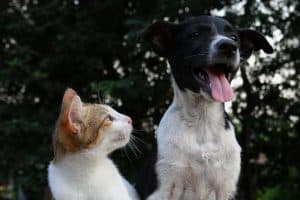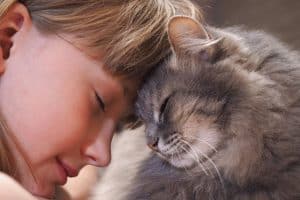Cats are often seen as more independent than dogs, but have you ever stopped to wonder why? What makes these mysterious felines so self-sufficient compared to their canine counterparts? Let’s delve into the fascinating reasons behind why cats are more independent than dogs.
Evolutionary Differences
When it comes to understanding why cats are more independent than dogs, we have to dive into their evolutionary history. Cats, as natural-born hunters, have evolved to be more self-reliant in order to survive in the wild. Unlike dogs, who were originally domesticated to work alongside humans, cats have maintained a sense of independence through centuries of evolution. This innate ability to fend for themselves has led to cats being less dependent on human interaction for their basic needs.
Moreover, cats are solitary hunters by nature, unlike dogs who tend to hunt in packs. This solitary behavior has further reinforced their independent streak, as they are used to relying on themselves for survival. In contrast, dogs have a pack mentality that promotes cooperation and dependence on others for support. This fundamental difference in their evolutionary backgrounds has played a significant role in shaping their behavior and level of independence.
Territorial Instincts
One key factor that contributes to cats’ independence is their strong territorial instincts. Cats are known to be highly territorial animals, marking their territory with scent glands located on their cheeks, paws, and tail. This territorial behavior stems from their innate need to establish and defend their own space, which in turn fosters a sense of independence.
Cats are wired to prioritize their territory above all else, ensuring they have a safe and secure environment where they can thrive on their own terms. This territorial instinct plays a crucial role in shaping their independent nature, as they are less inclined to rely on others for protection or companionship. Dogs, on the other hand, are more social animals who rely on the support and guidance of their pack members to navigate their surroundings.
In essence, cats’ territorial instincts serve as a driving force behind their independence, as they prioritize self-sufficiency and autonomy in their interactions with the world around them. By understanding and respecting their need for space and independence, we can foster a harmonious relationship with our feline friends based on mutual understanding and respect.
- Encourage independent activities for your cat, such as interactive toys or puzzle feeders, to stimulate their natural instincts and provide mental enrichment.
- Create designated spaces within your home that are solely for your cat, allowing them to establish their territory and feel secure in their environment.
- Respect your cat’s boundaries and give them the freedom to explore and roam at their own pace, reinforcing their sense of independence and autonomy.
Grooming Habits
Cats are known for their meticulous grooming habits, spending a significant amount of time each day licking themselves clean. This behavior not only helps them maintain a sleek appearance but also plays a crucial role in their independence. By constantly grooming themselves, cats are able to regulate their body temperature, distribute natural oils throughout their fur, and detect any abnormalities or parasites. This self-maintenance aspect of grooming allows cats to stay healthy and ward off potential health issues without relying on human intervention. Additionally, the act of grooming can provide cats with a sense of comfort and security, reinforcing their independent nature.
Hunting Abilities
One key factor that sets cats apart from dogs in terms of independence is their innate hunting abilities. Cats are natural-born predators with exceptional hunting instincts that enable them to fend for themselves in the wild. Their agile bodies, sharp claws, and keen sense of smell make them efficient hunters capable of catching prey to satisfy their nutritional needs. This self-sufficiency in finding food allows cats to survive and thrive independently, even if they are left to their own devices. Unlike dogs, which have been domesticated over centuries and often rely on humans for sustenance, cats retain their wild instincts and can tap into their hunting skills whenever necessary.
Additional Insight: Benefits of independence – Cats’ independence not only benefits themselves but also their owners. By being capable of taking care of their own grooming and hunting needs, cats require less attention and maintenance from their human companions, making them ideal pets for individuals with busy lifestyles or limited time for pet care.
Social Structures
Cats are more independent than dogs primarily due to their social structures. Unlike dogs, which are pack animals that thrive on social interaction and hierarchy, cats are more solitary by nature. Cats do not rely on social bonds for survival as much as dogs do, allowing them to be more self-reliant and independent in their behavior. Cats are also less likely to seek approval or guidance from their owners, as they are more accustomed to making decisions on their own.
Litter Box vs. Going Outside
One major factor that contributes to cats’ independence compared to dogs is their use of a litter box. Cats are naturally inclined to use a litter box for their bathroom needs, which allows them to stay indoors for extended periods without relying on their owners to let them out. In contrast, dogs need to go outside multiple times a day for bathroom breaks, making them more dependent on their owners for this basic need.
Here are some key differences between cats’ litter box habits and dogs’ need to go outside: – Cats can use a litter box at any time of day or night, providing them with the freedom to relieve themselves whenever they need to. – Dogs require their owners to take them outside for walks or to a designated bathroom spot, limiting their independence in this aspect. – Cats’ litter boxes are easily accessible and require minimal maintenance, whereas dogs’ outdoor bathroom breaks may be time-consuming and require more attention from their owners.
In conclusion, cats’ independence stems from their solitary nature and ability to use a litter box for their bathroom needs, which reduces their reliance on their owners for basic care.
Training Methods
Training cats is often more challenging than training dogs due to their independent nature. Cats are known for being more aloof and less eager to please compared to dogs, which can make it harder to train them to follow commands or behaviors consistently. On the other hand, dogs thrive on obedience and are more inclined to follow their owner’s lead, making them easier to train in a structured manner.
Cats are typically self-sufficient and have a higher level of autonomy than dogs, which can be attributed to their solitary hunting nature. They are natural hunters and are wired to rely on their own instincts and skills to survive. This independence translates into their behavior around humans, where they are less reliant on constant guidance or direction.
Training Tip: When training your cat, use positive reinforcement techniques such as treats or praise to motivate them to learn new behaviors. Cats respond better to rewards rather than punishment, as they are more likely to cooperate when they feel they are being rewarded for their efforts.
Emotional Independence
Cats exhibit a unique form of emotional independence that sets them apart from dogs. While dogs are known for their loyalty and desire for companionship, cats are more selective in forming bonds and seek out social interaction on their own terms. This emotional independence allows cats to thrive in various environments without constant human presence, unlike dogs who often require more attention and affection.
Despite their independent streak, cats still form strong attachments to their owners and can be affectionate and loving companions. However, they are more independent in their emotional expression, choosing when and how to show affection based on their own preferences and mood.
In summary, the combination of their solitary nature, independent behavior, and unique emotional independence all contribute to cats being more self-reliant and independent compared to dogs.
Unique Insight: Cats’ emotional independence may stem from their evolutionary history as solitary hunters, as they have had to rely on themselves for survival for thousands of years. This adaptability and self-sufficiency have translated into their modern-day behavior as independent and autonomous animals.
Interesting Facts
Cats’ independence stems from their nature as solitary hunters in the wild. Unlike dogs, who are pack animals dependent on their owners for guidance, cats have retained their wild instincts. They’re like tiny, furry ninjas, stalking their prey with precision. Cats’ ancestors needed to rely on themselves for survival, leading to their independent nature today. They’re the lone rangers of the animal kingdom! Cats also have a unique grooming behavior that solidifies their independence. They meticulously clean themselves to maintain their sleek fur and stay self-sufficient. Additionally, cats exhibit territorial behaviors, marking their space with scent glands to establish boundaries and maintain their independence.
Unique Insight
Another interesting aspect of cats’ independence is their ability to adapt to various environments. They embody the saying ‘curiosity killed the cat’ by exploring new places fearlessly. This adaptability allows them to survive and thrive in different situations, showcasing their independent spirit. Cats truly have nine lives when it comes to conquering new territories.
Key Differences
- Training: Cats can be litter-trained easily as they have a natural instinct to bury their waste. This makes them low-maintenance compared to dogs that require house-training.
- Feeding: Cats are obligate carnivores, meaning their diet relies heavily on meat. They can hunt small prey for food, showcasing their self-sufficiency.
- Socialization: While dogs require constant interaction with their owners for companionship, cats can entertain themselves for long periods, preferring solitude at times. This independence allows cats to be content on their own without feeling the need for constant attention.
Alex, a passionate animal lover, has experience in training and understanding animal behavior. As a proud pet parent to two dogs and three cats, he founded AnimalReport.net to share insights from animal experts and expand his knowledge of the animal kingdom.









